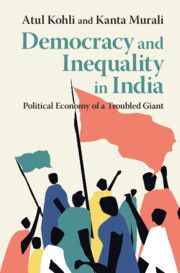Refine search
Actions for selected content:
638 results
Introduction
-
- Book:
- Charity After Empire
- Published online:
- 18 December 2025
- Print publication:
- 31 January 2026, pp 1-26
-
- Chapter
- Export citation
7 - ‘There is only starting at the bottom’
-
- Book:
- Peasants to Paupers
- Published online:
- 24 December 2025
- Print publication:
- 29 January 2026, pp 205-225
-
- Chapter
-
- You have access
- Open access
- HTML
- Export citation
3 - “Short Days They Lived on Earth …”
-
- Book:
- Death and the Afterlife in Syriac Christianity
- Published online:
- 17 December 2025
- Print publication:
- 22 January 2026, pp 61-92
-
- Chapter
- Export citation

Charity After Empire
- British Humanitarianism, Decolonisation and Development
-
- Published online:
- 18 December 2025
- Print publication:
- 31 January 2026
6 - Immaculate Conceptions
-
- Book:
- Anchoring an Empire
- Published online:
- 21 November 2025
- Print publication:
- 27 November 2025, pp 168-202
-
- Chapter
- Export citation
Can large-scale technology raise small-miner income and reduce mercury? Prospects for female waste-rock collectors selling ore to non-mercury processing plants
-
- Journal:
- Environment and Development Economics , First View
- Published online by Cambridge University Press:
- 06 November 2025, pp. 1-26
-
- Article
-
- You have access
- Open access
- HTML
- Export citation
Introduction
-
- Book:
- Democracy and Inequality in India
- Published online:
- 11 October 2025
- Print publication:
- 30 October 2025, pp 1-12
-
- Chapter
- Export citation
Transformative just transition as redistribution of income and wealth
-
- Journal:
- The Economic and Labour Relations Review ,
- Published online by Cambridge University Press:
- 20 October 2025, pp. 1-15
-
- Article
-
- You have access
- Open access
- HTML
- Export citation

Democracy and Inequality in India
- Political Economy of a Troubled Giant
-
- Published online:
- 11 October 2025
- Print publication:
- 30 October 2025
Poverty in Judgecraft: New Narratives through the Language of Equality – CORRIGENDUM
-
- Journal:
- German Law Journal ,
- Published online by Cambridge University Press:
- 02 October 2025, p. 1
-
- Article
-
- You have access
- Open access
- HTML
- Export citation
Orthodox Private Law and Social Subordination
-
- Journal:
- Canadian Journal of Law & Jurisprudence , First View
- Published online by Cambridge University Press:
- 01 October 2025, pp. 1-15
-
- Article
-
- You have access
- Open access
- HTML
- Export citation
Is income inequality a contributing factor to poverty and crime? Empirical evidence of the CIS nations
-
- Journal:
- Journal of International and Comparative Social Policy / Volume 41 / Issue 2 / July 2025
- Published online by Cambridge University Press:
- 30 September 2025, pp. 93-115
-
- Article
-
- You have access
- Open access
- HTML
- Export citation
‘A rope always snaps at its thinnest point’: structural factors contributing to childlessness among older men in a resource-constrained area
-
- Journal:
- Ageing & Society / Volume 46 / 2026
- Published online by Cambridge University Press:
- 26 September 2025, e9
- Print publication:
- 2026
-
- Article
-
- You have access
- Open access
- HTML
- Export citation
25 - Studies of Material Hardship in Psychological Anthropology
- from Part V - Postcolonial and Political–Economic Interventions
-
-
- Book:
- The Cambridge Handbook of Psychological Anthropology
- Published online:
- 22 October 2025
- Print publication:
- 25 September 2025, pp 604-628
-
- Chapter
- Export citation
Chapter 7 - Social Work in Need of Activism
- from Part I - Storying-to-Learn: How Stories-that-Matter Help Us Appreciate Social Work in Action
-
-
- Book:
- Learning through Social Work Stories-That-Matter
- Published online:
- 28 August 2025
- Print publication:
- 11 September 2025, pp 92-109
-
- Chapter
- Export citation
Chapter 5 - Dreams, Reality, and Invisibility
- from Part I - Storying-to-Learn: How Stories-that-Matter Help Us Appreciate Social Work in Action
-
-
- Book:
- Learning through Social Work Stories-That-Matter
- Published online:
- 28 August 2025
- Print publication:
- 11 September 2025, pp 58-77
-
- Chapter
- Export citation
Chapter 15 - Money (and Mythos)
- from Part IV - Paradoxes and Predicaments
-
-
- Book:
- Schoenberg in Context
- Published online:
- 04 September 2025
- Print publication:
- 04 September 2025, pp 153-162
-
- Chapter
- Export citation
Chapter 1 - A Sailor in the Family
-
- Book:
- Maritime Relations
- Published online:
- 23 August 2025
- Print publication:
- 04 September 2025, pp 18-59
-
- Chapter
- Export citation
The poverty and distributional impacts of carbon pricing on households: evidence from Ghana, Nigeria and Uganda
-
- Journal:
- Environment and Development Economics , First View
- Published online by Cambridge University Press:
- 04 September 2025, pp. 1-23
-
- Article
-
- You have access
- Open access
- HTML
- Export citation
Practices of Social Constitutionalism: Poverty, Socio-economic Status and Social Exclusion in the Jurisprudence of the German Federal Constitutional Court
-
- Journal:
- German Law Journal / Volume 26 / Issue 2 / March 2025
- Published online by Cambridge University Press:
- 01 September 2025, pp. 213-233
-
- Article
-
- You have access
- Open access
- HTML
- Export citation
